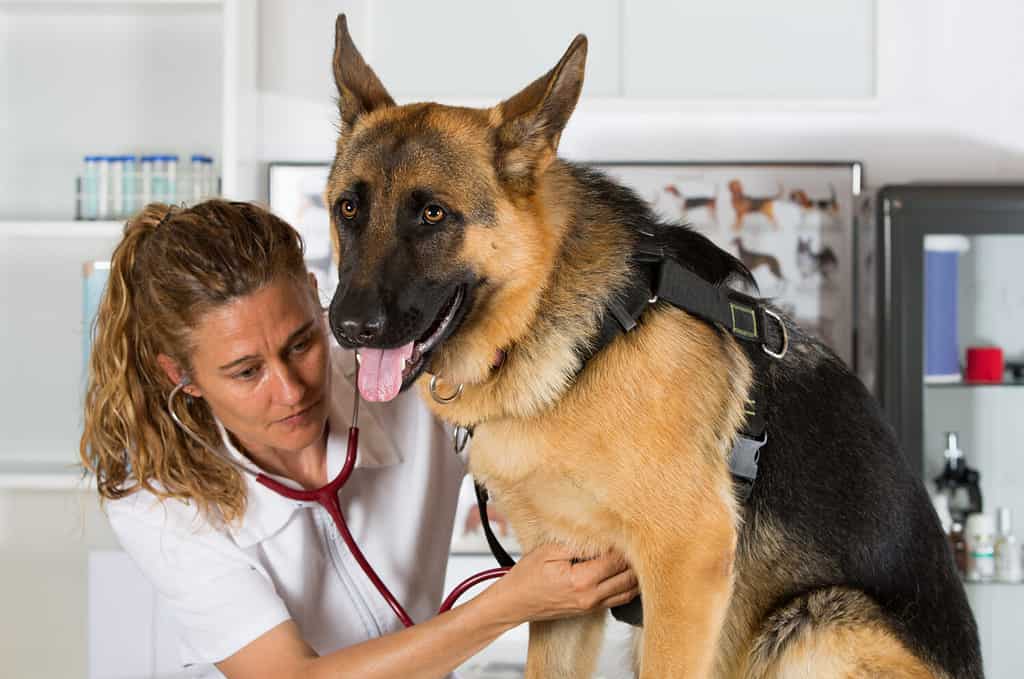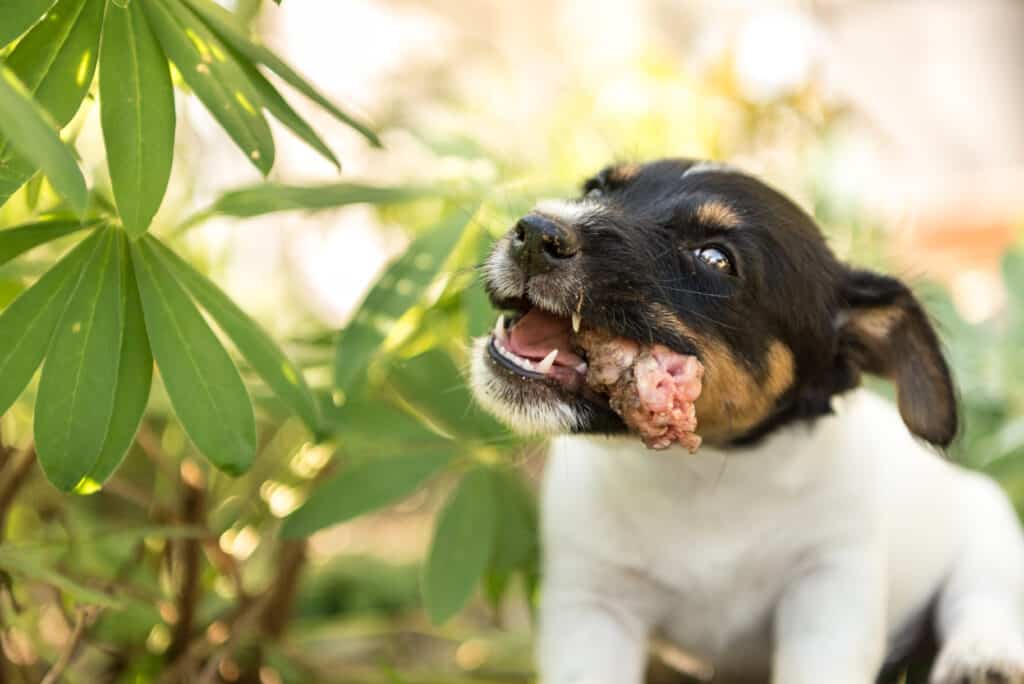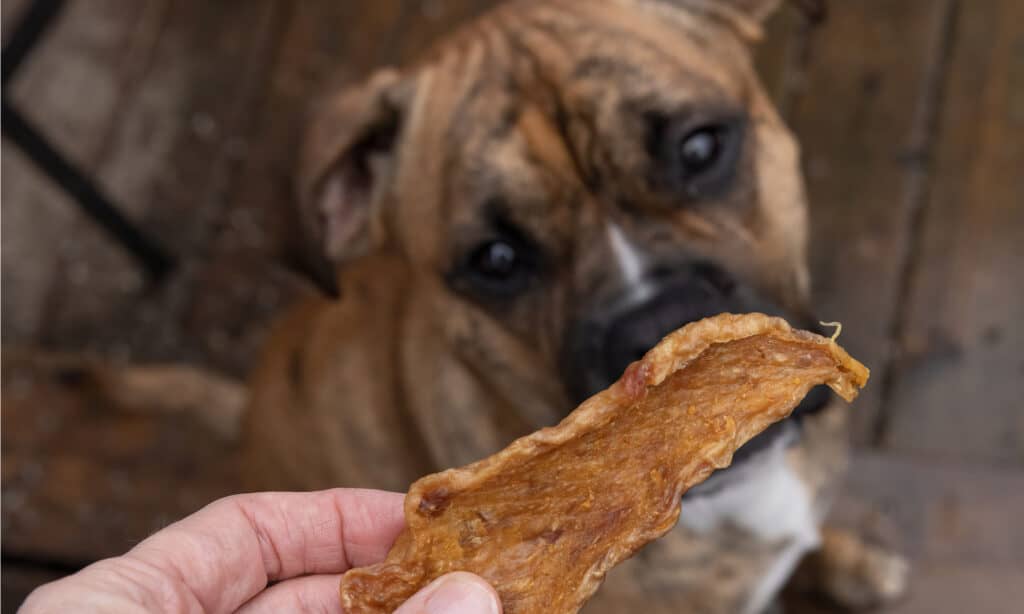If you’re the caregiver of a dog, you may be familiar with the term “resource guarding”. You may be pals with a dog who seems to struggle with guarding resources. Habitual resource guarding by dogs can be a source of chronic stress in a household for humans, dogs, and other pets alike.
In this guide, we’ll define resource guarding, describe its purpose for canines, and offer some helpful tips and perspectives on addressing resource guarding from your canine companion.
Read on to learn more.
Resource Guarding in Dogs: What Is It?
First, let’s define resource guarding. This is not a behavior limited to dogs, however, our definition will start as dog-specific.
In the domesticated dog, resource guarding manifests as the use of threatening, aggressive, or avoidant behaviors toward a person, dog, or other animal to maintain control of a valuable resource. It’s important to understand that the concept of “valuable resource” is subjective and different for each individual. We may feel that a dog guarding a stick is ridiculous, but value is entirely subjective. For instance, many humans fiercely guard their money as an immensely valuable resource- which most dogs would likely only see as valuable for enthusiastically shredding.
Dogs evolved as scavengers and resource-guarding behaviors aided them in retaining possession of scavenged items, especially food, among their social group. For dogs, behaviors associated with resource guarding are ritualistic displays meant to increase the distance of the other dog or animal, not to injure. In cohesive social groups of feral dogs, for instance, resource guarding only rarely escalates to injury-causing fights when space-distancing signals are repeatedly ignored.
In households, resource guarding by dogs can quickly become maladaptive when space-distancing signals aren’t listened to, when resources are poorly distributed among household dogs, and when resource guarding behaviors are punished by human caregivers.
Signs of Resource Guarding
If your dog is exhibiting resource guarding, you may notice the following subtle and not-so-subtle signs:
- stiffening/freezing over an item or in between the resource and the threat
- looking away, which can escalate to staring
- lip lifting
- growling
- snarling
- teeth baring
- lunging
- frantic eating or chewing of an item
- snapping
- biting (when threat displaying has not worked or communication has been suppressed)
You may see your dog exhibiting these signs related to guarding an object, food, person, space, or other animal. For example, your dog may attempt to guard the couch from other dogs or people. They may guard the doorway to a room where they regularly are fed. Or, they might display resource guarding around their toys. Resource guarding can happen in single or multi-dog households. There may be a genetic component, in addition to environmental, in regards to how intense or habitual the resource-guarding behaviors present.

Resource guarding is a natural, normal behavior that can become maladaptive and stressful for domesticated, pet dogs.
©Tatyana/iStock via Getty Images
How Caregivers Can Accidentally Cause Habitual Resource Guarding
Resource guarding in pet dogs can become habitual and maladaptive in response to how we interact with our canine companions. Typically, the more a dog resource guards, the less safe and comfortable they feel in their environment, which can stem from current or past experiences. You may adopt a dog who already has habitual resource-guarding behaviors due to negative experiences in their previous home.
The following are some examples of how humans can inadvertently cause or escalate resource guarding in dogs:
- Forcing dogs to “share” their items when they are uncomfortable
- Punishing communication that expresses discomfort and the need for space, such as growling, snapping, staring, etc.
- Consistently taking inappropriate items away from the dog without trading for an appropriate item. For example, someone may find themselves often taking objects away from a teething puppy without offering an acceptable chew toy in return.
- Displaying domineering behaviors towards dogs about their resources. A common example of this is taking food bowls away while dogs are eating, picking up a dog’s feet while they’re eating, etc.
- Feeding dogs too closely together, especially when one or more dogs are uncomfortable.
- Accidentally creating a scarcity environment between household dogs, such as having only one toy in a room.
A Note on Punishing Resource Guarding in Dogs
When our typically friendly and loving canine companion growls or snaps at us or another dog over a resource, our first instinct may be to react with frustration or anger. It’s understandable to feel hurt and upset, but it’s important to remember that resource guarding is a natural, normal behavior. The best action we can take is to help our dogs feel safe and secure in their environments. If we punish resource guarding, we’re making the situation much worse and potentially escalating the behavior into actually biting and fights.
If you approach your dog when they have a bone, they may growl and stiffen over the bone. You may respond by firmly saying “no!” and taking the bone away. After doing this several times, your dog is learning that communicating their discomfort results in a scolding and their bone taken away. So, they may suppress their communication since it only results in punishment. Below, we’ll explain why this suppression and punishment of communication is unethical and dangerous.
Communication Suppression is Unethical and Dangerous
Typically, behavioral suppression does not last permanently. Instead, the suppressed behavior may come back even more intensely than before. For example, at some point, if you approach them while they are chewing their bone, your dog may feel that they have no choice but to bite. From your perspective, you may have felt like the situation was fixed because your dog was no longer growling. But, your dog, still feels uncomfortable about you approaching their bone.
The only difference is now they know they will be punished if this discomfort is vocalized, so there’s no point in offering a warning. Instead, they may try to run away with the bone, frantically devour it, or even bite when you get too close. You may also find that your dog begins swallowing undigestible items because they are so anxious about you taking the object away.
This same situation can play out between dogs as well from punishment. Ultimately, the resource guarding will escalate and the situation can become injury-causing and dangerous. In addition, suppressing vocalization like growling unethically strips dogs of a crucial part of their communication.
How to Help Dogs with Habitual Resource Guarding
So, if punishment is unethical and makes the situation worse, then what can human caregivers do about resource-guarding in dogs? Firstly, we need to manage our expectations of our canine companions. This begins by recognizing when behaviors are normal and acceptable. If your dog is uncomfortable eating around other dogs or people, why force him to? You can support your pup by feeding him separately and advocating for him by making sure human residents and guests know to not bother your pup while he’s eating.
If you bring home meaty bones in a multi-dog household, you can prevent conflict by simply offering the bones in separate areas of the house and picking them up when you aren’t supervising. It’s also important to respect their communication. Most humans wouldn’t want to be messed with when we’re eating. And we certainly wouldn’t appreciate our housemates snatching the phone from our hands. By managing our expectations and attempting to understand the perspective of our dogs, we can be better friends and caregivers to our pups.
Treating Maladaptive Resource Guarding
However, if your dog is displaying maladaptive resource guarding in which the behavior is a chronic, stress-inducing, and even dangerous occurrence for everyone in the house, then it’s time to set up a plan.
Below, we’ll discuss ways to help your dog with habitual resource guarding feel more comfortable and safe in their environment. The focus will be on a scenario of a dog who resources and guards items from a person, but the overall perspective and methods of approach can apply to a variety of cases and scenarios. However, it’s crucial to understand that each scenario is unique and there is no one-size-fits-all solution. Instead, the focus in this guide is on explaining resource guarding, offering dog-centered perspectives, and providing tips for a specific scenario as a jump-off point for learning.
Resource Guarding in Dogs: Call in Help
First, if your dog is suddenly displaying these behaviors, it’s always a good idea to set up a vet appointment. Sometimes, underlying medical conditions can cause dramatic shifts in a dog’s behavior. It’s never a bad idea to rule out medical causes, especially in the case of sudden or confusing behavioral shifts.
Additionally, you can seek help from a force-free, qualified canine behaviorist. Avoid professionals who use “balanced” training, punishment, or dominance techniques, or use unethical, harmful tools such as shock, choke, and prong collars. A qualified, force-free, ethical behaviorist will be able to explain how resource guarding is a normal, natural behavior and can help set up a plan to help your pup feel more comfortable and secure. The more comfortable your pet is, the less likely they will be to feel the need to habitually resource guard.

If your dog is exhibiting a sudden shift in behavior, it’s always a good idea to set up a thorough vet check. This may include blood panels.
©135pixels/Shutterstock.com
Manage the Environment and Resources
Especially in a multi-dog household, it’s crucial to make sure you aren’t accidentally creating an environment of scarcity or escalating conflict between dogs.
If your dogs only start bickering if there is only one toy in the room, for example, make sure there are multiple toys available. This creates an environment of abundance. However, this is not the solution for every household. Sometimes, you’ll need to make sure no toys or chew items are freely available. Instead, only offer the items individually to your dogs in separate spaces. How you go about this will depend on the relationship between your dogs and the level of resource guarding exhibited.

If your dog is possessive over bones, it’s important to manage the environment by not leaving bones around the house.
©iStock.com/K_Thalhofer
Resource Guarding in Dogs: Create Trust
If your dog is habitually resource-guarding, especially from you, one crucial step to take is to build trust with your dog. If your pup growls when you come near their bone, take a step back and listen to that communication. Remember to try not to take it personally. The fundamental key in this situation is to help your dog feel more at ease when you are around a valuable resource.
You’ll want to establish how far away you can be with your dog comfortable around the resource. If the resource guarding is intense and on the verge of danger, you’ll want to remove that item for now, if possible. But, don’t remove the item in front of your dog! You can wait for your dog to walk away on their own. Or, put a bowl of high-value food down in another area for your dog and then pick up the item.
Establish a Safe Distance and Offer Treats
Next, try to find an item that your dog enjoys, but doesn’t get too intense over. Establish a distance in which your pup feels comfortable sharing space with you and the item. Then, call their name while they have the item and toss a treat in their direction. Practice this multiple times a day and from different angles of approach. Start to incrementally close the distance that you stand when you toss the treat. You can also practice walking by and tossing the treat. If your dog starts stiffening or exhibiting other signs of stress, back off to a distance in which they are comfortable. Then, move forward in even smaller increments, perhaps even simply shifting your weight a bit forward.
The goal is to eventually be able to approach your dog while they have the item and drop or hand feed the treat. This could take days or weeks, depending on how your dog feels and how deeply ingrained the behaviors are.
Trade, Don’t Take
If you have gotten to the point where you can approach your dog with their item and drop or hand feed a treat then you can begin offering trades. Trading is an immensely important aspect of helping your pup feel safe with their items. If you only take items away from them, your dog will likely feel distrustful of you and anxious. This often results in habitual resource guarding.
When trading, the item you offer should be as good or better than what they already have. The goal here is to facilitate your dog feeling excited about you calling them over or approaching them while they have their item because you have been consistently tossing them high-value treats, like pieces of cheese.
For this step, you can begin by smearing cheese or peanut butter on a long spoon. Offer the spoon, and say “trade” in a cheerful tone. As your dog drops the item lick the spoon, direct the spoon away from the item, and briefly touch or pick it up while your dog enjoys licking the treat. This should only happen if your dog is relaxed and you have thoroughly practiced tossing treats in their direction without making any attempt to touch their guarded item.

Help your dog feel more comfortable and less anxious around their resources by tossing treats when they have a valuable item. Start from a safe distance and incrementally work your way closer based on your dog’s comfort level.
©sarah Tee/Shutterstock.com
Resource Guarding in Dogs: The Goal is a Comfortable Pup
After briefly touching or picking up the toy, return the item to your dog and move away. Repeat this several times per session and make sure to take a step back if your dog begins to appear stressed. These sessions should be comfortable and safe for everyone. Ultimately, your dog will learn that offering you their item is rewarding and safe for them.
You may eventually even graduate to teach your dog to bring you items in exchange for high-value treats or other toys. These trading games should be a consistent part of living with your pup. Trading can both prevent and treat habitual resource guarding when done at your dog’s pace and comfort level.
The photo featured at the top of this post is © alexei_tm/iStock via Getty Images
Thank you for reading! Have some feedback for us? Contact the AZ Animals editorial team.







